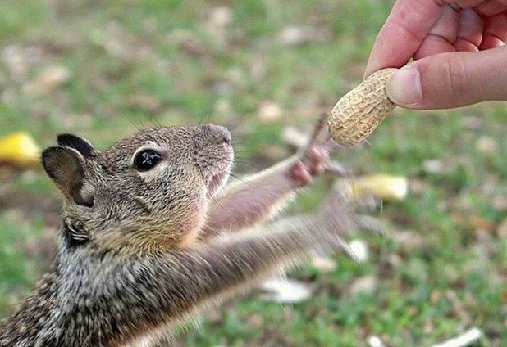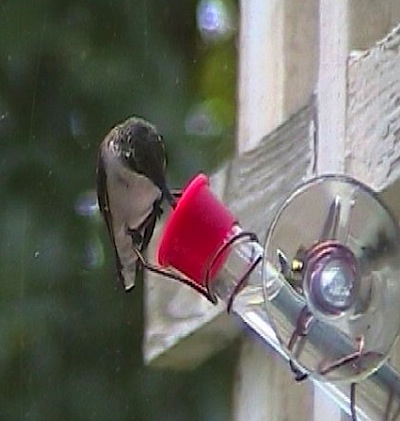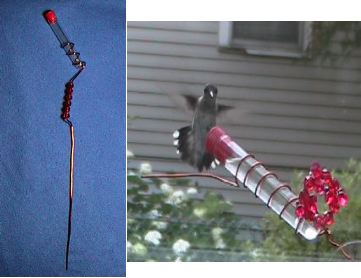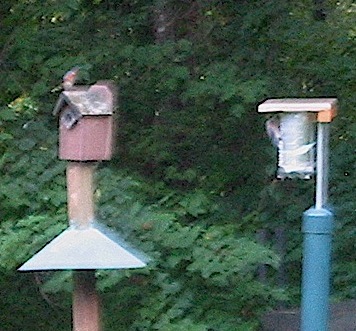- Bird Feeders, Squirrel Proof Bird Feeder, Squirrel Proof Bird Feeders, Tube Bird Feeder, Uncategorized, Wild Bird Feeders
super squirrel proof bird feeders
If you’re a little bird-crazy like us, keeping feeders filled is a priority that takes time – in fact it’s a daily chore lately due to some bully birds hanging around the yard. Only filling feeders about one quarter of capacity, because no matter what’s offered… it’s gone in a few hours! And we’re not even talking squirrels here… grackles, starlings and doves are the culprits. Isn’t it time for them to move on yet?
Because squirrels are enough menace in their own right, every single bird feeder has a baffle on it, even bluebird houses have baffles to protect nests from curious paws. But outwitting the critters really isn’t as difficult as some may think. Squirrel Proof Bird Feeders with cages like this are very effective against both squirrels and larger, less desirable birds. Some of the caged feeders are let’s say, kind of cheesy, but this large capacity model is super quality and made in the USA. With a big three gallon capacity, and built in seed tray to catch waste, this super squirrel-resistant feeder even has an innovative design that makes it simple to fill and clean. The PVC feeder tube will never yellow like some of the acrylic tubes, and stainless steel feeder ports retain their shiny new look.
Don’t get us wrong… we feed the squirrels too, but somehow that’s never enough either. May be time to look into one of these for our own yard? And although a bit overboard with our wildlife habitat, that’s not really us feeding this furry friend – although it is kinda cute!
-
window hummingbird feeder trains sprites for hand feeding!
Sometimes it’s the tiniest things that can bear the biggest impact. Hummingbirds for example, are the smallest of beaked migratory visitors, but their performances are anything but small in stature! Putting on some of the greatest shows with their expert acrobatics and natural antics, it’s no wonder these tiny sprites continue to mesmerize and endear so many people.
Not too terribly shy either, once they become regulars at backyard fountains or feeders, and familiar with their hosts… they’ll buzz by so close you can feel the breeze from their speedy wings! It happened just today… while changing nectar in the window hummingbird feeder – her swift movement caused a swooshing breeze and a bass-like buzz that went right by my head… it made for a pretty magical experience!
Oh, and the tiny tube feeder on the window? It’s actually part of set that lets you train hummingbirds to eat from your hand (well almost). The idea is once they get used to the tubes, you sit quietly holding the feeder by the copper wand and the sprites come right up and eat – within twelve or so inches from you. One feeder is staked to set in a flower pot or plant, the other a window feeder. It’s actually pretty cool, but does require a little bit of patience. Training time may vary depending on how well your hummingbirds know you.
A tiny little feeder set for some tiny birds that promise to bring some big amazement to your world!
-
some blue bird houses are seeing 3rd or 4th nesting!
It’s been a strange season for birds in general due to the lengthy winter weather. Because some parts of the country were still seeing snow in late April and early May, mortality rates among nestlings were higher than usual. Colder than normal temps along with scarcity of natural food sources may have also accounted for some unsuccessful migrations of favorite feathered friends like hummingbirds. Many folks have reported seeing fewer of these sprites around feeders early in the season this year.
On the flip side, resident birds whose nesting season is about over, are attempting later than usual broods. Many blue bird houses which have already fledged two or three sets of nestlings are seeing their third and even fourth clutch of the season! This is all wonderful news for bluebirds… except for the searing temperatures July and August can bring.
If it’s hot outside, guaranteed it’s hotter inside a birdhouse. Babies can not regulate their body temperatures until they reach a certain age, but there are a few things you can do to help bluebirds (and others) beat the heat. First and foremost is to keep blue bird houses out of the sun, especially that baking afternoon sun. Moving a box a few feet where it’s shaded in the afternoon makes a difference in the ambient temperature inside the box. To featherless nestlings, just a few degrees can mean the difference between life or death. Birdbaths and Leaf Misters also help birds cool down during extreme heat. Parents will even shake themselves over babies dripping a bit of water to cool them.
Crazy as it sounds, there are other ways to cool down blue bird houses. Setting an ice pack or two on top of the house, attached with a large rubber band or bungee will help to cool temps inside. Recent discussions revealed a few folks putting up umbrellas to shade their nest boxes, again attached with bungee cords. Last summer we even wrapped our
Gilbertson nest box with a heat shield – the kind used for car windshields! Easy to measure, and simple to cut, duct tape and rubber bands held the soft shield securely in place. The blues didn’t mind it all, and it helped their digs and babies stay cooler. Four fledged in mid-August of 2012. Stats like these mean it’s not too late to offer bluebirds housing. At the very least, you may be providing a nightly winter roost for other resident birds.
The image isn’t so great, but you can see the foil-like cover on the round blue bird house to the right. It literally took five minutes to complete this easy project, and may have helped save four babies from succumbing to horrid heat.






